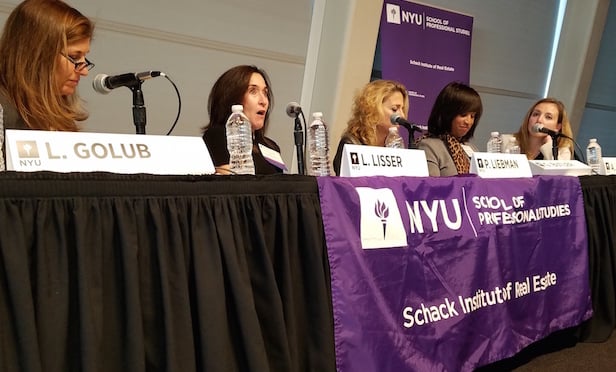
NEW YORK CITY—Gwendolyn L. Butler, vice chairwoman and CMO of Capri Capital Partners, a global real estate investment management group headquartered in Chicago, said her best growth periods occurred when she took jobs no one else wanted and exceeded in delivering results.
“Recognize that you have to work harder than your male peers in order to get the same level of recognition but don't get caught up in the emotions related to that,” said Butler.
She also noted, “As an African American woman in the business, I am a unicorn but that doesn't bother me because I know who I am.” She advised the audience to use their differences as advantages.
Pamela Liebman, president and CEO of the Corcoran Group, also told conference attendees not to fear being different and to take risks. “If you follow what everyone else is doing, you'll end up in the same place,” she said.
Lesley Lisser, LEED accredited professional director, asset management at Invesco Real Estate, advised people to believe in their stories and they will get to where they want to be.
Their advice equally applies to multifamily property investors facing the challenges that these three executives addressed with fellow panelist Allina Boohoff, managing director at JPMorgan Chase & Co, and moderator Laurie Golub, formerly COO and general counsel, HFZ Capital Group. All were part of the NYU School of Professional Studies Schack Institute of Real Estate's “National Symposium of Women in Real Estate,” held on Wednesday at the Kimmel Center for University Life. Their session was titled “Outlook for the Multifamily Sector.”
Liebman pointed out that the median price of real estate in New York City is double the national average. Buying an apartment and paying real estate taxes is expensive and the cost of living is extraordinarily high, she said. That partially explains the residential outgrowth of Manhattan to the suburbs and the NJ waterfront.
“But it's a problem. Affordability is our biggest problem,” said Liebman. “Nobody likes the sticker shock of walking into an apartment, and it's a studio and you're walking up three flights of stairs, and it's $3,000 a month. It's really rough.”
In addition to the shortage of affordable housing, the city has an oversupply of high end residential units which has resulted in a severe softness in the luxury rental market, according to Liebman. After the frenzy of building that occurred during the last cycle, Liebman says she has never seen so much of a supply of luxury rentals. Apartments at top notch buildings such as 15 Central Park West were renting at $20,000 per month, but are now looking at $15,000.
“There are just a lot of luxury rentals and the question becomes who can afford to pay these crazy rents?” asked Liebman.
With talk of the federal government changing the tax policy to eliminate state property tax deductions, high state taxes, high rents, tuition for private schools, people are leaving the city. “And these are the people who can actually afford these kinds of rent,” she said.
Boohoff also sees a softening of luxury rentals, not just in New York but across the country. With the increased building and costs continuing to rise, developers needed to charge very high rents to make sense of the numbers, she said.
In looking towards residential property solutions, Lisser said as there are more children in luxury rentals, Invesco has located housing near high performing schools and good transit systems. In the suburbs, under these circumstances, renters are staying. Plus, empty nesters are moving back into cities, as a growing demographic throughout her portfolio.
Half of millennials, the generation whose ages range from 22 to 37, are now in their 30s. Although they delayed buying homes, now they are moving to the suburbs. Boohoff referenced colleagues who built residential properties in Jersey City. They leased over 748 apartments within nine months, and are calling Jersey City the hottest market on the East Coast.
Butler noted there is a growing demand for housing for working families, for people such as teachers, policemen and firemen. Instead of continuing to develop high-end luxury apartments, she sees a strong opportunity in workforce housing. “There's such an unmet demand that even with the growth of multifamily over the last decade, all of us investors totally ignored,” said Butler. “The market totally ignored the development of workforce housing. It's really a great unmet need.”
It's not just about vibrant diversity, culture and urban character described in Jane Jacobs' book, The Death and Life of Great American Cities. Instead of short-term immediate financial gains followed by severe losses, institutional investors and pension fund investors would benefit from long-term success in real estate investments. Butler said for secular investors, while looking at job growth, demographic trends and urbanization, multifamily properties throughout market cycles, still offer attractive, risk-adjusted returns on investments.
Want to continue reading?
Become a Free ALM Digital Reader.
Once you are an ALM Digital Member, you’ll receive:
- Breaking commercial real estate news and analysis, on-site and via our newsletters and custom alerts
- Educational webcasts, white papers, and ebooks from industry thought leaders
- Critical coverage of the property casualty insurance and financial advisory markets on our other ALM sites, PropertyCasualty360 and ThinkAdvisor
Already have an account? Sign In Now
*May exclude premium content© 2025 ALM Global, LLC, All Rights Reserved. Request academic re-use from www.copyright.com. All other uses, submit a request to [email protected]. For more information visit Asset & Logo Licensing.








